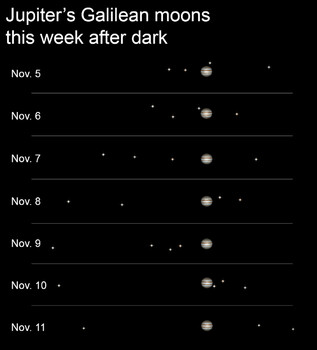By Jove, It's Jupiter!
Last updated 11/21/2023 at 1:37pm
What is that bright light glowing low in the east just after dark? An airplane? The International Space Station? A UFO? The answer is none of the above. It's the planet Jupiter!
Jupiter has returned to our evening sky after many months of absence, outshining everything else except the moon. That's because it now lies near its opposition point and, as the term implies, the planet appears opposite in the sky from the sun. In other words, not long after you see the sun set in the west, you'll see Jupiter rise in the east.
Of course, Jupiter is always fun to view through a telescope, but during the month or two around its opposition, the planet lies closest to the Earth and therefore appears significantly larger through an eyepiece. This makes it even easier to see many of its famous features shown in photographs.
The largest planet of our Solar system, Jupiter boasts a diameter more than 11 times that of the Earth. It has no surface on which to stand, just an atmosphere of thick, swirling gases and clouds. And because this immense gaseous world rotates on its axis in less than 10 hours, all of its atmospheric weather systems are stretched into parallel cloud bands that cross its face.
But that's not all. Jupiter is surrounded by a huge family of moons. When I was in elementary school, I remember learning that Jupiter had nine moons orbiting nearby. The thought of so many moons seemed crazy! Today, however, modern telescopic and spacecraft observations have shown us that between 80 and 95 moons orbit the planet, and we're pretty sure that there are thousands of smaller moons that we haven't yet detected.
If I had been born a few centuries earlier, I would have learned that Jupiter had only four moons. That's what the Italian astronomer Galileo found in January 1610 when he turned his small telescope toward the planet. He saw four bright "bambino stars" nearby and, to his surprise, noticed that they seemed to change their positions from night to night.
It was only after watching them for a few weeks that he figured out what was going on. These were moons orbiting the planet! Today we know these as the Galilean moons: Io, Europa, Ganymede and Callisto.
What's most fascinating to me about Jupiter, and what makes it my favorite planet to view, is that with just a small backyard telescope, we can see its active atmospheric cloud bands and even the four Galilean moons. We now have plenty of time to check it out, because Jupiter will appear in our evening sky throughout the winter months.
To identify the moons' names, just do an internet search for "Jupiter moons apps" and you'll find some programs to label them all right on your smartphone. And if the moons don't match precisely with the illustration here, it may be because your telescope inverts or reverses images differently.
If you don't have a telescope, don't worry. Your local amateur astronomy club, observatory or science museum does, and they frequently offer free "star parties" during which you can enjoy Jupiter all winter long.




